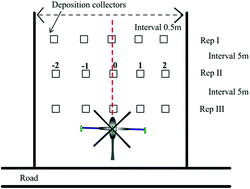Use of RhB and BSF as fluorescent tracers for determining pesticide spray distribution
Abstract
Fluorescent tracers are frequently used in spray tests, but their stability under illumination and rate of elution and recovery from the deposition carrier are crucial to the accuracy of the test results. Spectral analysis has shown that the absorbing wavelengths for RhB and BSF are 573.8 nm and 494.6 nm, respectively, at most under uninterrupted sunlight and their recovery rates are 93.5%–98.2% and 95.5%–99.4%, respectively. In favourable light stability, a great part of both colouring agents can be eluted and recovered from glass slides and mylar card but not so much from filter paper. Because of the tracers being influenced by light, when using a mylar card as a receiver, different coloured plastic boards were used as pads, and it was found that a red pad can increase the recovery of elution by three percent in 2 hours. Our goal was to determine which chemicals would be most suited for use as tracers for the simulation of long-distance transport of pesticides in aerial spraying by evaluating the effects of spraying pattern on spraying deposition and drift potential of pesticide sprays. Tests undertaken on a farm showed that the two colouring agents studied can be effectively used as tracers to investigate droplet deposition of pesticides sprayed by a UAV on paddy rice farms in a low volume. The above test results show that RhB can be feasibly used as a tracer to examine droplet deposition of pesticides aerially sprayed in a low volume.



 Please wait while we load your content...
Please wait while we load your content...